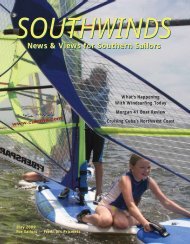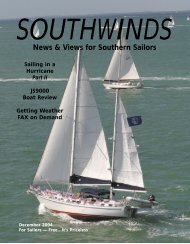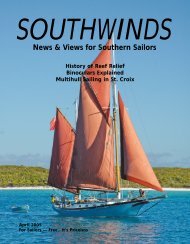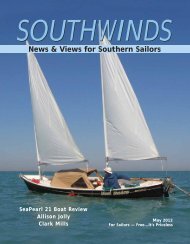Southwinds Sailing June 2004 - Southwinds Magazine
Southwinds Sailing June 2004 - Southwinds Magazine
Southwinds Sailing June 2004 - Southwinds Magazine
- No tags were found...
Create successful ePaper yourself
Turn your PDF publications into a flip-book with our unique Google optimized e-Paper software.
flying colorful spinnakers, our parade of brilliant flowers glidedsilently, save the occasionally ratchety winch, due north on thefirst leg of the 38-mile course from Palatka to Jacksonville.Passing the power plant bend, we turned east, and thebeam reach of the next leg separated the pack, as those whoflew big genoas could crank up their apparent wind speed.But soon enough, we turned northerly and were back to whatpromised to be a day of leisurely downwind running.Meg, her fears allayed as the spinnaker floated in the gloriousbreeze, went below for a nap. This un-race-like behaviorcaused her to miss the fleet of small catamarans and onedesigndinghies as they raced by in iridescent colors, lookingfor all the world like water beetles weaving among the lumberingcruisers..When Hutch’s watch was over, the spinnakerwas doused, and Meg took the helm so Hutch could alsoindulge in un-race-like behavior. Around 1:30 p.m., she calledbelow, softly at first as not to intrude on his meditation, thenwith greater insistence. “We’re dead in the water, Captain,and almost all the boats have left us behind.” Concerned thatwe had run aground, Hutch came above to see that we’d enteredthe dreaded Picolata doldrums. The river was oily calm,and all the cruisers within sight appeared virtually stationary,as roasting flesh sizzled in the cockpits. We scroungedfor every available square inch of cloth to hang, and endedup with the main, jib, and spinnaker wafting, the biminiangled forward to catch any stray wind molecules, and towelstied between the shrouds. Along the shore’s edge, weghosted along. Soon, we felt a puff, then another, and soonwere making way. What a sight as we rounded the bend - 90boats in one long, clear stretch of river. The wind was definitelycoming around, and soon the spinnaker, which hadevolved into a gennaker, had to come down, as Meg experiencedwhat being overpowered by a sail means.Ground-strike lightning was now preceding the distantrumbling we’d been hearing for some time, and the thundergained volume. Clouds down-course blackened quickly. Twostorm cells on either side of the river suggested we mightglide through without a drop, but it wasn’t to be. Reportsradioed in from the SeaRay safety crews, ever ready withweather updates, reported that the lone wind surfer hadswamped and was being brought in. The SeaRays startedsearching for and assisting numerous capsized Hobie Cats.We battened down, got the reefing lines ready, and donnedthe raingear. Suddenly Aurora Blue was ripping along in araging Force 7 gale. All those Hornblower stories became realas our jaunty craft plowed through the roiling St. Johns sea.For years, we’ve always chosen to go out in weather—hiking,biking, or in our canoe—as that is when Her Majesty Natureis most splendid, and you can usually count on being alone.But we weren’t alone, as just ahead we spied a twomastedwooden sailing canoe remaining gamely upright, evenas it was being swamped by large waves. Its luffing foresailwas approximately eight square feet, its main less than twenty.We looked for the skipper, but nary a soul was in sight. Thenwe saw him in the water holding onto the boat. We jibedaround and asked if perhaps he could use some assistance,and he opined that yes, indeed, that would be most welcome.We treated this as a crew overboard drill, headed up, andretrieved the floating line from the lazarette. Up close, circumstancesappeared a bit more out of control, so Hutch swamthe rope over to lash the canoe to our boat. The skipper wasbrought aboard, using the winch and a good grip on hiswetsuit. When Captain Halsey, who looked to be a spry eighty,mentioned he was probably getting too old for this, we recognizeda kindred spirit. We hope to still be sailing in weatherwhen we reach his age.After a SeaRay took Captain Halsey and his craft aboard,we reviewed our drill and found it wanting in some key areas,such as our inability to radio our position because a fewweeks earlier our GPS had not returned from its own overboarddrill. In gale conditions, it’s difficult to stop a boat. Wewere simply lucky that we’d been able to hold position longenough to get a rope to the canoe without drifting apart, andour recently installed swim-ladder certainly saved the day.After this diversion, we were determined to finish therace. The bone went between the teeth; we bellowed Arrrgh!and headed back into the wind with a reefed main and the jibstowed. We’re no estimators of windspeed, but the radiowarnings were for 50-knot gusts and the sting of the horizontalrain wouldn’t deny it. There was no shoreline, so with onlythe compass and depth-finder as guides, we clawed north.Eventually the storm abated, and in the binoculars appearedThe Mug, tipped over but magically not spilling its contents.With the finish line in sight, we performed our obligatory turnsin snappy nautical fashion and looked back in exhilaration -there were still a few boats behind us! We saluted the raceofficials as they asked us where our registration numbers were(they’d blown off the sail), and we congratulated ourselvesover spaghetti and beer for finishing the first of our manyMug Races to come.Robert Hutchinson and Meg Niederhofer won theCorinthian Cup…for the last boat to finish.They sail in Aurora Blue, a 21-foot Sirius, with the Gulf-Atlantic Yacht Club of Gainesville. HutchRK@aol.comMELBOURNE YACHT CLUB SPRING REGATTAAPRIL 17-18 AND APRIL 24-26by Sherry BeckettThe <strong>2004</strong> edition of Melbourne Yacht Club’s “laid back” SpringRegatta followed through on the MYC promise of “great sailing,great food, free beer and awesome trophies.”The first weekend of the two-weekend event was for smallboats; primarily one-design racing sailboats under 20 feet. Thelargest fleet attending was the Sunfish class, with 14 boatscompeting, including such notables as Linda Tillman, JamesLiebl, Tony Elliot, and Paul Strauley. The wind was fairlystrong both days, favoring the younger sailors. James Lieblwalked away with first place, with wins in five of six races.In the seven-boat Laser fleet, Dick Tillman also walkedaway with his class, with wins in five of six races. Battling itout for second and third were Mike Moody from Michiganand David Hartman from Vero Beach. Tied with 11 points atthe end of six races, Mike won second place on the tiebreaker,by taking a first place in the last race.A contingent of Force 5 racers came up from South Floridato make a five-boat class. Jim Bigham and Steve Perry, bothfrom Miami, swapped firsts a number of times throughoutsix races. The pair ended up tied for first with eight points,but Jim Bigham won the class with a first place in the lastrace. The third and fourth place boats were also tied on points,NEWS & VIEWS FOR SOUTHERN SAILORS SOUTHWINDS <strong>June</strong> <strong>2004</strong> 41
















